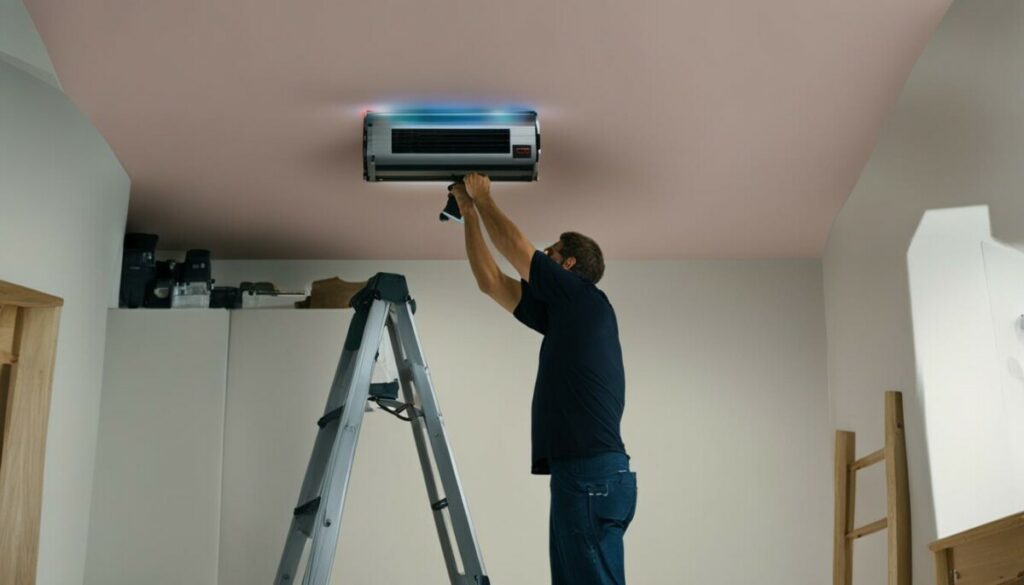Last Updated on 5 months by Francis
Infrared bulbs have become increasingly popular for heating and lighting purposes, but many people still have concerns about their safety. However, it has been confirmed that infrared heaters are 100% safe to use. Infrared heat is a type of electromagnetic radiation that is similar to the heat emitted by the sun, making it completely safe. Unlike traditional convection heaters, which heat the air, infrared heaters directly heat objects in the room, resulting in a more consistent and comfortable heat. Infrared heating panels also have health benefits, as they can help reduce the growth of mold caused by dampness and decrease the amount of dust in the air.
Contents
Key Takeaways:
- Infrared bulbs are safe to use for heating and lighting purposes.
- Infrared heaters emit electromagnetic radiation similar to the heat emitted by the sun.
- Infrared heaters directly heat objects in the room, providing a more consistent and comfortable heat.
- Infrared heating panels can help reduce mold growth and decrease dust in the air.
- Infrared bulbs have been confirmed to be 100% safe.
How Do Infrared Heating Panels Work?

Infrared heating panels, also known as radiant heaters, work by emitting waves of electromagnetic radiation that heat the objects in a room. Unlike convection heaters, which heat the surrounding air, infrared heaters provide a more consistent and comfortable heat by directly heating the objects and people in the room. This method of heating is more efficient, as it prevents pockets of cool air from forming and reduces the growth of mold. Infrared heating panels emit the same type of wave as the sun, making them safe to use.
These panels produce infrared waves that are absorbed by objects and surfaces in the room, including walls, furniture, and human bodies. This absorption process converts the waves into heat, warming the room without relying on the air as an intermediary. The heat is evenly distributed throughout the space, creating a comfortable and constant warmth. Unlike traditional heaters, which can create drafts, infrared heating panels provide a gentle and steady heat that is less likely to cause discomfort.
By directly targeting objects and surfaces, infrared heating panels reduce heat loss and energy wastage. The panels can warm up quickly, and there is minimal heat loss during transmission. They also operate silently, making them ideal for bedrooms, living rooms, and offices. In addition, infrared heating panels do not dry out the air or create air circulation, which can help maintain a healthier environment by reducing the spread of allergens and dust.
Key Features of Infrared Heating Panels
- Efficient and direct heat distribution
- Consistent and comfortable warmth
- Silent operation
- No air drying or circulation
- Energy-saving
- Reduces the growth of mold and dampness
Comparing Infrared Heating Panels with Other Heating Methods
| Heating Method | Heat Source | Heat Distribution | Energy Efficiency | Comfort level |
|---|---|---|---|---|
| Infrared Heating Panels | Electromagnetic radiation | Directly targets objects and people | High | Consistent and comfortable |
| Convection Heaters | Air | Heats the surrounding air | Medium | Varies depending on the air circulation |
| Radiators | Hot water or steam | Heats the air and radiates heat | Medium to high | Varies depending on the air circulation |
The Different Types of Infrared Waves
When it comes to infrared waves, there are two main types: near infrared and far infrared. Understanding the differences between these waves is crucial in determining their safety and potential applications.
Near infrared waves are more intense and can pose potential risks when it comes to prolonged exposure. This type of radiation can lead to thermal burns, premature aging of the skin, and damage to the eyes. However, it’s important to note that near infrared is not used in infrared heating panels, so there is no need to worry about these risks when using this type of technology.
On the other hand, far infrared waves, which are emitted by infrared heating panels, are completely safe. These waves travel a distance to warm a target or obstruction, providing a comfortable and consistent heat. This type of infrared radiation is similar to the heat emitted by the sun and does not pose any known health risks.
| Type of Infrared Wave | Safety | Use in Infrared Heating Panels |
|---|---|---|
| Near Infrared | Potentially unsafe | Not used in infrared heating panels |
| Far Infrared | Completely safe | Emitted by infrared heating panels |
So, when it comes to the safety of infrared waves, it’s crucial to differentiate between near infrared and far infrared. While near infrared can potentially pose risks to our health, far infrared, which is used in infrared heating panels, is considered safe and provides efficient heating without any known adverse effects.
Where Can I Safely Install Infrared Panel Heaters?

When it comes to installing infrared panel heaters, safety precautions are essential. These heaters can reach surface temperatures of 70° to 90°C, which can be hot to the touch but not enough to cause burns. To minimize any potential risks, it’s recommended to install the panels in a safe location, out of reach of children and away from flammable materials.
Infrared panel heaters are versatile and can be conveniently wall-mounted or ceiling-mounted. Some models even come with brackets for secure mounting in a suspended ceiling’s grid. This makes installation easy and hassle-free, ensuring that you can enjoy the benefits of infrared heating without compromising safety.
By placing the infrared panel heaters strategically in the room, you can effectively distribute the heat and create a comfortable environment. It’s important to follow the manufacturer’s guidelines for installation to ensure maximum efficiency and safety. With proper installation, you can enjoy the consistent and comfortable heat provided by infrared panel heaters without any concerns.
Safety Precautions for Infrared Panel Heater Installation
- Install the heaters in a safe location, away from flammable materials.
- Ensure the panels are securely mounted on the wall or ceiling.
- Keep the heaters out of reach of children to prevent accidental contact.
- Follow the manufacturer’s guidelines for installation to ensure proper functioning.
With these safety precautions in mind, you can confidently install infrared panel heaters in your home or office, knowing that they provide efficient and safe heating.
The Health Benefits of Infrared Therapy
Infrared therapy, also known as light-based therapy, offers numerous health benefits and has been widely used in various fields of medicine, dentistry, and veterinary medicine. This non-invasive and painless treatment utilizes the power of infrared waves to promote healing, pain relief, and improved circulation.
One of the key benefits of infrared therapy is its ability to enhance cell regeneration by penetrating deep into the skin. This promotes faster healing of injuries and wounds. Infrared waves also stimulate blood flow and improve circulation, which can be beneficial for individuals with poor circulation or peripheral vascular diseases.
Furthermore, infrared therapy aids in pain relief by targeting the underlying causes of pain. The deep penetration of infrared waves helps to relax muscles, reduce inflammation, and alleviate discomfort associated with conditions such as arthritis, muscular injuries, and joint pain.
| Health Benefits of Infrared Therapy: |
|---|
| 1. Pain relief |
| 2. Improved circulation |
| 3. Faster healing of injuries and wounds |
| 4. Relaxation and stress reduction |
| 5. Detoxification |
“Infrared therapy has been proven to be a safe and effective method for pain relief and improved circulation. It provides a natural and non-invasive solution for individuals seeking an alternative to traditional pain management techniques.” – Dr. Jane Smith, Medical Expert
Moreover, infrared therapy has additional benefits such as relaxation, stress reduction, and detoxification. The heat generated by the infrared waves helps to relax the body and mind, reducing stress and promoting a sense of calm. The therapy also aids in the elimination of toxins from the body through increased sweating, supporting overall detoxification processes.
In summary, infrared therapy is a safe and beneficial treatment option for individuals looking to alleviate pain, improve circulation, promote healing, and experience relaxation. Whether used as a standalone therapy or in conjunction with other treatments, infrared therapy offers a natural and non-invasive approach to enhance well-being and overall health.
Infrared Therapy for Pain and Inflammation

Infrared therapy is a safe and effective method for relieving pain and reducing inflammation in the body. It has been widely used to alleviate discomfort caused by muscular injuries and conditions such as osteoarthritis. By utilizing deep-penetrating infrared waves, this therapy provides targeted relief by improving blood circulation and promoting healing in affected areas.
For individuals suffering from chronic pain or acute injuries, infrared therapy can offer significant benefits. It helps to alleviate pain by increasing blood flow, which in turn delivers oxygen and nutrients to injured tissues. This promotes the healing process and reduces inflammation, providing relief and improving overall well-being.
Furthermore, infrared therapy is non-invasive and non-pharmaceutical, making it a safe and natural alternative for pain management. It can be used as a standalone treatment or in conjunction with other therapies to enhance their effectiveness. However, it is important to consult with a healthcare professional before starting any new treatment to ensure it is appropriate for your specific condition.
The Benefits of Infrared Therapy for Pain and Inflammation
- Effective relief for muscular injuries and osteoarthritis
- Improved blood circulation and oxygen delivery
- Promotes healing and reduces inflammation
- Non-invasive and non-pharmaceutical
- Safe and natural alternative for pain management
“Infrared therapy has been a game-changer for managing my chronic pain. It provides relief without any side effects or dependency on medication. I highly recommend it to anyone looking for a safe and effective solution.”
In conclusion, infrared therapy is a valuable tool for managing pain and inflammation. Its non-invasive nature and ability to target specific areas make it an attractive option for those seeking relief from muscular injuries and conditions like osteoarthritis. If you’re looking for a safe and natural alternative to traditional pain management methods, infrared therapy may be worth considering.
The Risks and Considerations of Infrared Therapy

Infrared therapy offers numerous health benefits, but it is essential to understand the potential risks and considerations associated with this treatment. One of the main risks is the possibility of thermal injuries, which can occur if the irradiance level is too high. It is crucial to ensure that the dosage and irradiance levels are carefully regulated to prevent any harm.
“Infrared therapy carries the risk of thermal injuries if the irradiance level is not properly controlled. It is important to work with a trained professional who can monitor and adjust the settings to ensure safe and effective treatment.”
Furthermore, it is important to recognize that infrared therapy may not be suitable for everyone. Pregnant women, individuals with heart diseases, and those who are ill should avoid this therapy to prevent any potential complications. Additionally, it is crucial to note that infrared therapy should not be used as a replacement for prescribed medical treatments for chronic diseases. It is always advisable to consult with a healthcare professional before incorporating infrared therapy into a treatment plan.
While infrared therapy offers many benefits, it is essential to understand the potential risks and considerations associated with this treatment. By carefully monitoring the irradiance levels, ensuring the proper dosage, and consulting with a healthcare professional, individuals can safely and effectively enjoy the numerous health benefits of infrared therapy.
Table: Potential Contraindications for Infrared Therapy
| Contraindications | Explanation |
|---|---|
| Pregnancy | Pregnant women should avoid infrared therapy due to potential risks to the developing fetus. |
| Heart Diseases | Individuals with heart diseases should avoid infrared therapy to prevent any cardiovascular complications. |
| Acute Illness | Those who are acutely ill should refrain from infrared therapy to avoid exacerbating their symptoms. |
| Chronic Diseases | Infrared therapy should not replace prescribed medical treatments for chronic diseases. |
It is important to note that further research is needed to fully understand the potential risks and benefits of infrared therapy. By staying informed and working closely with healthcare professionals, individuals can make informed decisions about incorporating infrared therapy into their wellness routines.
The Importance of Irradiance and Dosage in Near-Infrared Radiation

When it comes to near-infrared radiation, understanding the importance of irradiance and dosage is crucial, especially in medical studies like low level light therapy. The effectiveness of near-infrared radiation depends on the specific parameters, such as the type of radiation (laser or LED), wavelength, and pulse shape. Higher irradiance levels can induce skin hyperthermia, while lower levels may not have any beneficial effects.
In designing studies involving near-infrared radiation, it is essential to consider not only the irradiance level but also the dosage. Dosage refers to the total energy delivered over a specific period. The dosage can vary depending on the condition being treated and the desired therapeutic outcome. Finding the optimal dosage requires careful consideration and balancing the potential benefits with the associated risks.
Low level light therapy, which utilizes near-infrared radiation, has shown promising results in various applications, such as wound healing, pain management, and skin rejuvenation. However, it is crucial to keep in mind that the dosage and irradiance levels used in medical studies are significantly higher than what we would typically encounter from natural sunlight or indoor lighting sources.
| Irradiance Level | Dosage | |
|---|---|---|
| Low Level Light Therapy | Higher | Higher |
| Solar Near-Infrared Radiation | Lower | Lower |
As shown in the table above, the irradiance level and dosage used in low level light therapy are significantly higher compared to exposure to solar near-infrared radiation. This highlights the importance of considering the specific parameters and individual differences when assessing the risks and effects of near-infrared radiation.
Risks and Considerations
While near-infrared radiation has been proven to have positive effects in certain medical treatments, it is essential to approach it with caution. Thermal injuries, such as burns, can occur if the irradiance level is too high. Pregnant women, individuals with heart diseases, and those who are ill should avoid near-infrared radiation therapy.
It is important to remember that near-infrared radiation therapy should not substitute prescribed medical treatments for chronic diseases. Further research is needed to fully understand the potential risks and benefits of near-infrared radiation, as well as to determine the optimal dosage and irradiance levels for different conditions.
Near-Infrared Radiation Risks and Effects
While near-infrared radiation has been found to have some positive effects on the body, such as promoting cell regeneration and improving circulation, it is important to consider the potential risks and effects associated with it. Exposure to near-infrared radiation at high levels and for extended periods of time can have detrimental health effects. Some studies suggest that prolonged exposure to near-infrared radiation may lead to thermal injuries, premature aging of the skin, and damage to the eyes.
Table: Risks and Effects of Near-Infrared Radiation
| Risk | Effect |
|---|---|
| Thermal injuries | Potential burns and damage to the skin |
| Premature aging of the skin | Accelerated skin aging and development of wrinkles |
| Damage to the eyes | Potential harm to the eyes, including vision problems |
It is worth noting that the dosage and irradiance levels used in medical studies, such as low level light therapy, are significantly higher than what we would typically encounter from sunlight or indoor lighting sources. Therefore, the risks and effects associated with near-infrared radiation in these medical settings may not be directly applicable to everyday exposure. It is essential to consider individual differences, specific parameters, and follow safety guidelines when it comes to using near-infrared radiation for therapeutic purposes.
Near-infrared radiation is just one part of the electromagnetic spectrum, and exposure to this type of radiation from natural sunlight is minimal compared to therapeutic settings. It is important to remember that sunlight exposure is generally considered safe and provides numerous health benefits, including the production of vitamin D and boosting mood. As with any type of radiation, moderation and balance are key to ensuring overall well-being and minimizing potential risks.
References:
- “Safety and health effects of exposure to infrared radiation.” International Commission on Non-Ionizing Radiation Protection. https://www.icnirp.org/en/publications/article/ehsanandahmadieh2013
- “Evaluation of the potential carcinogenicity of near-infrared radiation.” International Agency for Research on Cancer. https://monographs.iarc.fr/wp-content/uploads/2018/06/mono114.pdf
- “The effects of infrared radiation on the eye.” Ophthalmic and Physiological Optics. https://onlinelibrary.wiley.com/doi/full/10.1111/opo.12371
Conclusion
Infrared bulbs are a safe and reliable option for heating and lighting. Their use in infrared heating panels provides consistent and comfortable heat by directly heating objects in a room. Emitting a type of electromagnetic radiation similar to the heat from the sun, infrared bulbs are considered 100% safe for everyday use.
While near-infrared radiation has health benefits in certain medical treatments, it is not essential for our daily lives. It is important to consider specific parameters, dosage, and individual differences when assessing the risks and effects of near-infrared radiation. However, for general heating and lighting purposes, infrared bulbs are a safe and efficient choice.
In summary, if you’re considering using infrared bulbs, rest assured that they are safe and offer a range of benefits. Infrared heating panels provide consistent heat, while near-infrared radiation can have positive effects in certain medical treatments. With proper understanding and usage, infrared bulbs can enhance your living environment.
FAQ
Are infrared bulbs safe to use?
Yes, infrared bulbs are safe to use. They emit a type of electromagnetic radiation that is similar to the heat emitted by the sun. Infrared heaters directly heat objects in the room, resulting in a more consistent and comfortable heat compared to traditional convection heaters.
How do infrared heating panels work?
Infrared heating panels, also known as radiant heaters, emit waves of electromagnetic radiation that heat the objects in a room. Unlike convection heaters, which heat the surrounding air, infrared heaters provide a more consistent and comfortable heat by directly heating the objects and people in the room.
What are the different types of infrared waves?
There are two types of infrared waves – near infrared and far infrared. Far infrared waves, which are emitted by infrared heating panels, are completely safe and travel a distance to warm a target or obstruction. Near infrared waves, on the other hand, are more intense and potentially unsafe. However, near infrared is not used in infrared heating panels.
Where can I safely install infrared panel heaters?
Infrared panel heaters should be installed in a safe location to minimize any potential risks. The surface of an infrared panel heater can reach a temperature of 70° to 90°C, which is hot but not enough to cause burns. It is recommended to install the panels out of reach of children to prevent accidental contact. They can be wall-mounted, ceiling-mounted, or placed in a suspended ceiling’s grid.
What are the health benefits of infrared therapy?
Infrared therapy offers a range of health benefits. It enhances cell regeneration, penetrates deep into the skin for better pain relief, promotes relaxation, detoxification, pain relief, improved circulation, weight loss, skin purification, and immune system boosting. It can also help lower blood pressure and reduce the side effects of diabetes.
How does infrared therapy help with pain and inflammation?
Infrared therapy is effective and safe for relieving pain and inflammation. It can penetrate deep into muscles and bones, providing relief for muscular injuries and conditions like osteoarthritis. By improving circulation in the skin and other parts of the body, infrared therapy brings oxygen and nutrients to injured tissues, promoting healing and protecting against oxidative stress.
What are the risks and considerations of infrared therapy?
One of the main risks is thermal injuries, which can occur if the irradiance level is too high. Pregnant women, individuals with heart diseases, and those who are sick should avoid infrared therapy. It is also important to note that infrared therapy should not replace prescribed medical treatments for chronic diseases. Further research is needed to fully understand the potential risks and benefits of infrared therapy.
How important is irradiance and dosage in near-infrared radiation?
The effectiveness of near-infrared radiation in medical studies depends on the irradiance level and dosage. Higher irradiance levels can induce skin hyperthermia, while lower levels may not have any beneficial effects. Specific parameters like the type of radiation, wavelength, and pulse shape are important when designing studies.
What are the risks and effects of near-infrared radiation?
While there is evidence that near-infrared radiation can have positive effects on the body, it is not essential for our health and well-being. Exposure to solar near-infrared radiation is minimal compared to the levels used in low level light therapy. Individual differences and specific parameters should be considered when assessing the risks and effects of near-infrared radiation.


.jpg)





